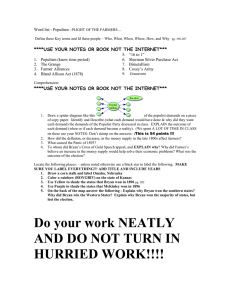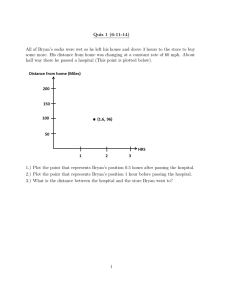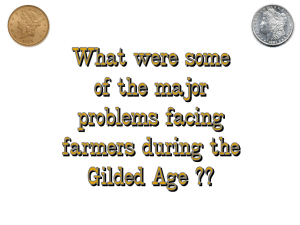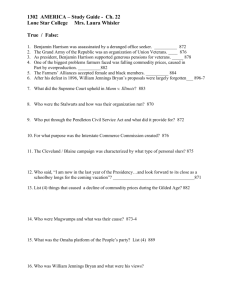– Unit 9, Chapter 23 (12 Ed.)
advertisement
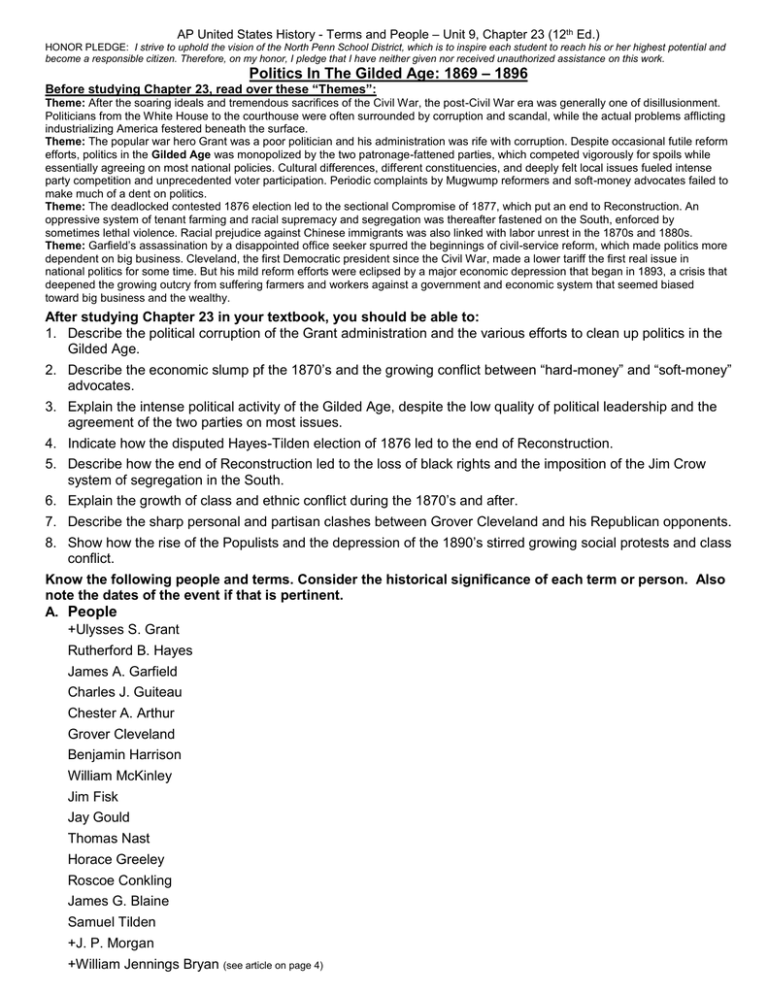
AP United States History - Terms and People – Unit 9, Chapter 23 (12th Ed.) HONOR PLEDGE: I strive to uphold the vision of the North Penn School District, which is to inspire each student to reach his or her highest potential and become a responsible citizen. Therefore, on my honor, I pledge that I have neither given nor received unauthorized assistance on this work. Politics In The Gilded Age: 1869 – 1896 Before studying Chapter 23, read over these “Themes”: Theme: After the soaring ideals and tremendous sacrifices of the Civil War, the post-Civil War era was generally one of disillusionment. Politicians from the White House to the courthouse were often surrounded by corruption and scandal, while the actual problems afflicting industrializing America festered beneath the surface. Theme: The popular war hero Grant was a poor politician and his administration was rife with corruption. Despite occasional futile reform efforts, politics in the Gilded Age was monopolized by the two patronage-fattened parties, which competed vigorously for spoils while essentially agreeing on most national policies. Cultural differences, different constituencies, and deeply felt local issues fueled intense party competition and unprecedented voter participation. Periodic complaints by Mugwump reformers and soft-money advocates failed to make much of a dent on politics. Theme: The deadlocked contested 1876 election led to the sectional Compromise of 1877, which put an end to Reconstruction. An oppressive system of tenant farming and racial supremacy and segregation was thereafter fastened on the South, enforced by sometimes lethal violence. Racial prejudice against Chinese immigrants was also linked with labor unrest in the 1870s and 1880s. Theme: Garfield’s assassination by a disappointed office seeker spurred the beginnings of civil-service reform, which made politics more dependent on big business. Cleveland, the first Democratic president since the Civil War, made a lower tariff the first real issue in national politics for some time. But his mild reform efforts were eclipsed by a major economic depression that began in 1893, a crisis that deepened the growing outcry from suffering farmers and workers against a government and economic system that seemed biased toward big business and the wealthy. After studying Chapter 23 in your textbook, you should be able to: 1. Describe the political corruption of the Grant administration and the various efforts to clean up politics in the Gilded Age. 2. Describe the economic slump pf the 1870’s and the growing conflict between “hard-money” and “soft-money” advocates. 3. Explain the intense political activity of the Gilded Age, despite the low quality of political leadership and the agreement of the two parties on most issues. 4. Indicate how the disputed Hayes-Tilden election of 1876 led to the end of Reconstruction. 5. Describe how the end of Reconstruction led to the loss of black rights and the imposition of the Jim Crow system of segregation in the South. 6. Explain the growth of class and ethnic conflict during the 1870’s and after. 7. Describe the sharp personal and partisan clashes between Grover Cleveland and his Republican opponents. 8. Show how the rise of the Populists and the depression of the 1890’s stirred growing social protests and class conflict. Know the following people and terms. Consider the historical significance of each term or person. Also note the dates of the event if that is pertinent. A. People +Ulysses S. Grant Rutherford B. Hayes James A. Garfield Charles J. Guiteau Chester A. Arthur Grover Cleveland Benjamin Harrison William McKinley Jim Fisk Jay Gould Thomas Nast Horace Greeley Roscoe Conkling James G. Blaine Samuel Tilden +J. P. Morgan +William Jennings Bryan (see article on page 4) AP United States History - Terms and People – Unit 9, Chapter 23 (12th Ed.) HONOR PLEDGE: I strive to uphold the vision of the North Penn School District, which is to inspire each student to reach his or her highest potential and become a responsible citizen. Therefore, on my honor, I pledge that I have neither given nor received unauthorized assistance on this work. James B. Weaver Tom Watson Thomas Reed B. Terms: soft/cheap money (free silver) - (see article on pages 5 and 6) hard/sound money (gold standard) - (see article on pages 5 and 6) bimetallism (see article on pages 5 and 6) contraction (see article on pages 5 and 6) resumption Gilded Age spoils system *Pendleton Act Civil Service Commission crop-lien system pork-barrel bills populism grandfather clause “Ohio Idea” the “bloody shirt” Tweed Ring Credit Mobilier Whiskey Ring Liberal Republicans “Crime of ‘73” Greenback Labor party Grand Army of the Republic (GAR) stalwart half-breed Compromise of 1877 Mugwumps “Redeemers” *Plessy v. Ferguson Jim Crow *Chinese Exclusion Act U.S. v Wong Kim jus soli as compared to jus sanguinis Billion-Dollar Congress People’s (Populist) Party Sherman Silver Purchase Act McKinley Tariff Social Gospel (see article on page 4) +=One of the 100 Most Influential Americans of All Time, as ranked by The Atlantic. Go to Webpage to see all 100. *=A 100 Milestone Document from the National Archive. Go to Webpage to link to these documents. AP United States History - Terms and People – Unit 9, Chapter 23 (12th Ed.) HONOR PLEDGE: I strive to uphold the vision of the North Penn School District, which is to inspire each student to reach his or her highest potential and become a responsible citizen. Therefore, on my honor, I pledge that I have neither given nor received unauthorized assistance on this work. C. Sample Essays: Using what you have previously learned and what you read in Chapter 23, you should be able to answer an essay such as this one: What made politics in the Gilded Age extremely popular – with over 80% voter participation – yet so often corrupt and unconcerned with issues? D. Did you know? The term "The Gilded Age" comes from a novel of the same name published in 1873 by Mark Twain (+) and Charles Dudley Warner: The Gilded Age: A Tale of Today. Though fictional, it is a critical examination of politics and corruption in the United States. The book explored how rampant economic and political corruption colored American society and culture during the Gilded Age. The central characters, Colonel Beriah Sellers and Senator Abner Dilworthy, are tied together in a government railroad bribery scheme. Twain and Warner depict an American society that, despite its appearance of promise and prosperity, is riddled with corruption and scandal. E. Voices from the past: If they say bimetallism is good, but that we cannot have it until other nations help us, we reply, that instead of having a gold standard because England has, we will restore bimetallism, and then let England have bimetallism because the United States has it. If they dare to come out in the open field and defend the gold standard as a good thing, we will fight them to the uttermost. Having behind us the producing masses of this nation and the world, supported by the commercial interests, the laboring interests and the toilers everywhere, we will answer their demand for a gold standard by saying to them: You shall not press down upon the brow of labor this crown of thorns, you shall not crucify mankind upon a cross of gold. William Jennings Bryan, July 8, 1896, at the Democratic National Convention "When I finished my speech," Bryan recalled later, "I went to my seat in a silence that was really painful. When I neared my seat, somebody near me raised a shout, and the next thing I was picked up and bedlam broke loose." For an hour the shouting delegates marched about the hall. Even gold standard men were caught up by the excitement. The next day Bryan was chosen to be the Democratic nominee. F. Immigration by Decades: 1820 – 1969 Years Immigrants 1820-1829 128,502 1830-1839 538,381 1840-1849 1,427,337 1850-1859 2,814,554 1860-1869 2,081,261 1870-1879 2,742,287 1880-1889 5,248,568 1890-1899 3,694,294 1900-1909 8,202,388 1910-1919 6,347,380 1920-1929 4,295,510 1930-1939 699,375 1940-1949 856,608 1950-1959 2,499,268 1960-1969 3,213,749 AP United States History - Terms and People – Unit 9, Chapter 23 (12th Ed.) HONOR PLEDGE: I strive to uphold the vision of the North Penn School District, which is to inspire each student to reach his or her highest potential and become a responsible citizen. Therefore, on my honor, I pledge that I have neither given nor received unauthorized assistance on this work. G. William Jennings Bryan – Orator For the People A review by Leonard Boasberg of Michael Kazin’s book A Godly Hero: The Life of William Jennings Bryan. I was born and raised in Nebraska and grew up as an admirer of Nebraska’s William Jennings Bryan, “the Great Commoner,” three times the Democratic nominee for president, a passionate progressive who for decades led the fight for social justice. Then, in 1960, I saw Inherit The Wind, the film based on the 1955 play that depicted Bryan, in the character of Matthew Harrison Brady, as a sanctimonious, bloviating Bible-thumper in the famous Scopes “monkey trial,” the State of Tennessee vs. John Thomas Scopes. I suspect that most Americans, when they think of Bryan, think of the fictional character rather than the real person. In his excellent biography, Michael Kazin, portrays the real William Jennings Bryan, a politician beloved by millions. He was arguably the most eloquent orator in American political history, in an age when people paid attention to political oratory. Thousands of people flocked to hear him and be inspired. In 30 years he delivered more than 6,000 speeches, often five a day. He was far in advance of any major political leader in calling for the expansion of the power of the federal government to serve the interests of the working and middle classes. He spoke out for labor’s right to organize and go on strike, for subsidizing farmers, for a graduated income tax, for women’s suffrage, and for requiring national banks to insure the funds of their depositors. He proposed the direct election of U.S. senators 17 years before its time came in 1913. In 1924, in the wake of the Teapot Dome scandal, he proposed that the federal government pay “legitimate” campaign expenses, including advertising — an idea whose time has not yet come. In short, Kazin says, “he did more than any other man to transform his party from a bulwark of laissez-faire into the citadel of liberalism we identify with Franklin D. Roosevelt and his ideological descendents.” Bryan’s politics was infused with his ardent faith in Christianity. To him, Christianity meant the Social Gospel; that is, a good Christian should devote himself to reforming society and the world, to side with the common people against the forces of privilege, corruption and “the money power.” His speeches were replete with biblical references. Calling for the free coinage of silver, he electrified the 1896 Democratic convention with perhaps his most famous utterance: “You shall not press down upon the brow of labor this crown of thorns; you shall not crucify mankind upon a cross of gold.” Much of Bryan’s indictment of contemporary politics might have been spoken yesterday: “Men sell their votes; councilmen sell their influence, while state legislators and federal representatives turn the government from its legitimate channels and make it a private asset in business. A Godly Hero is a sympathetic but far from sycophantic biography. The Democratic Party in Bryan’s time was a white man’s party, much of its strength based in the South. Bryan himself and most white Social Gospelers were blind to racial injustice. Bryan did condemn lynching (which was more than Republican President William Howard Taft would do), but be avoided the issue of the disenfranchisement of blacks in the South. He was no intellectual, nor even a particularly thoughtful man. Richard Hofstadter, in his classic The American Political Tradition, quotes Oswald Garrison Villard as writing: “Of all the men I have seen at close range in thirty-one years of newspaper service, Mr. Bryan seemed to me to be the most ignorant.” Christian moralist that he was, to the point of self-righteousness, Bryan could on occasion compromise his principles. In 1900, during his second crack at the White House, he made his peace with New York City’s corrupt Tammany Hall machine. He opposed imperialism and the war with Spain, but he endorsed the peace treaty that provided for the American occupation of the Philippines. He stuck by his principles, though, when he resigned as Secretary of State over fear that President Woodrow Wilson’s policies would lead to American participation in the European war. Wilson was glad to see him go. In 1909 he joined the crusade for Prohibition. He was a zealous foe of Darwinism, though not a fundamentalist as we understand the word. He appreciated science; he simply believed he was defending Christianity. The Gilded Age, Kazin observes, was not unlike our own: “Large corporations still dominate our economy, bankroll our politicians, and frame our mass culture. Pious, if often intemperate, voices still denounce the corrosive impact of modern society and look to a spiritual awakening to cleanse the body politic.” Where are the eloquent, charismatic, principled politicians now? H. What is “The Gold Standard,” “Bimetallism,” and “Free Silver”? Read on to find out: AP United States History - Terms and People – Unit 9, Chapter 23 (12th Ed.) HONOR PLEDGE: I strive to uphold the vision of the North Penn School District, which is to inspire each student to reach his or her highest potential and become a responsible citizen. Therefore, on my honor, I pledge that I have neither given nor received unauthorized assistance on this work. The Gold Standard, Bimetallism, or 'Free Silver'? The bitter controversy surrounding the issues of "free silver" and "sound money," so central to the 1896 campaign, has proved difficult for historians to explain. Partisans on both sides made exaggerated claims of the impact monetary policy could have on the nation's economic health. They implied that coinage of silver (on Bryan's side) or adherence to the gold standard (on the Republican side) was the single key to prosperity--and sometimes to the nation's honor. Oddly, before 1896 both McKinley and Bryan had focused more attention on the tariff than on currency issues. Despite his party's platform, McKinley sought to emphasize the tariff and to avoid being labeled a "monometallist" or "bimetallist," leading to accusations of waffling. While he was a Congressman, Bryan allegedly once said that "the people of Nebraska are for free silver, so I am for free silver. I will look up the arguments later." His 1896 campaign became a free silver crusade. Since the Civil War, a series of third parties had criticized Republicans' policy of contracting the money supply. Lincoln's issue of Greenbacks, the first national paper money, had helped finance the war but it also stimulated inflation. In subsequent decades, national Republican leaders sought to withdraw the greenbacks until each dollar had 100% backing in metal reserves. During the economic depressions of the 1870s and 1890s, in particular, this policy was roughly opposite to that which today's Federal Reserve might pursue in an economic downturn. It drew criticism as tending to favor bankers and lenders--who needed the value of a borrowed dollar to hold steady, or increase, until it was repaid--and detrimental to borrowers and workers. Heirs to the Greenback Party of the 1870s believed that paper money was the solution. In post-war decades, however, the opening of vast silver veins (such as Nevada's Comstock Lode) had sharply increased the nation's silver supply. To Silver Democrats, federal coinage of silver (at a weight ratio of 16 ounces to 1 ounce of gold, hence the slogan "16 to 1") was a moderate solution to the currency problem. After all, silver was a precious metal, not mere paper. "Free silver" thus temporarily allowed a spectrum of currency reformers--from Southern Democrats to Populists--to unite. To horrified Gold Democrats and Republicans, "free silver" was an appeal for cheaper dollars. It would cheat lenders of an honest return on their money, allowing profligate borrowers to steal value from those who had extended loans. Free silver at "16 to 1" would have expanded the money supply, but as a lone measure it would hardly have solved the nation's economic woes, and it would have (as Republicans argued) substantially raised the value of silver in relation to gold. Yet adherence of 'sound money' was not solely--or even primarily--responsible for the country's return to prosperity after 1896. To the extent that McKinley's victory reassured investors and financial institutions, whose leaders were frightened of Bryan, resolution of the issue may have had an indirect economic impact. After the campaign, however, the currency question faded quite rapidly from political debate. 'Free silver' and 'sound money' may have been most important as shorthand slogans for broader philosophies of finance and public policy, and opposing beliefs about justice, order, and 'moral economy.' Cartoons and commentary from the campaign, focusing heavily on the currency question, provide insights into these differing worldviews. A "Silver Bug Pin" for sale in the 1896 campaign AP United States History - Terms and People – Unit 9, Chapter 23 (12th Ed.) HONOR PLEDGE: I strive to uphold the vision of the North Penn School District, which is to inspire each student to reach his or her highest potential and become a responsible citizen. Therefore, on my honor, I pledge that I have neither given nor received unauthorized assistance on this work. Bimetallism and the Gold Standard In economics, bimetallism is a monetary standard in which the value of the monetary unit can be expressed either with a certain amount of gold or with a certain amount of silver: the ratio between the two metals is fixed by law. This monetary system is very unstable: due to the fluctuation of the commercial value of the metals, the metal with a commercial value higher than the currency value tends to be used as metal and is withdrawn from circulation as money (Gresham's Law). This occurred in the United States throughout the 19th century as the official bimetallic standard became in effect a silver standard. In the United States, toward the end of the nineteenth century, bimetallism became a center of political conflict. Newly discovered silver mines in the American West caused an effective decrease in the value of money. This created a conflict between those that favored inflationary policies caused by a bimetallic standard and those that favored sound money produced by a gold standard. Bimetallism and "free silver" were favored by Democrats, populists, and Western states with silver mines, in contrast to the gold standard which was favored by financial interests in the East Coast. William Jennings Bryan, the eloquent champion of the cause, gave the famous "Cross of Gold" speech at the National Democratic Convention on July 9, 1896 asserting that "The gold standard has slain tens of thousands." He referred to "a struggle between 'the idle holders of idle capital' and 'the struggling masses, who produce the wealth and pay the taxes of the country;' and, my friends, the question we are to decide is: Upon which side will the Democratic Party fight?" At the peroration, he said "You shall not press down upon the brow of labor this crown of thorns, you shall not crucify mankind upon a cross of gold." However, his presidential campaign was ultimately unsuccessful and 1896 saw the election of William McKinley who implemented the gold standard in 1900. The phrase “gold standard” is defined as the use of gold as the standard value for the money of a country. If a country will redeem any of its money in gold it is said to be using the gold standard. An individual would be able to take any type of legal tender to the proper authorities and redeem that form of money for gold at a specified rate. In short, the gold standard was a force for stability. Silver, not nearly as rare as gold, had been the standard for most of the world's currencies until the Industrial Revolution in the 19th century. The increase in world trade which accompanied industrial development led to demands for the adoption of the gold standard. Britain, the first industrialized power, adopted the gold standard around 1820. The United States did not follow suit until 1873 (the Coinage Act of 1873, or known to its critics as the "Crime of '73"). The gold standard came under bitter attack in the United States, first by the National Greenback Party in the 1870s and later by the Democrats under William Jennings Bryan, particularly in the Election of 1896. The U.S. and many other Western countries adhered to the gold standard during the early 1900’s. Today, however, gold’s role in the worldwide monetary system is negligible. Britain abandoned the gold standard 1931. In the U.S., President Franklin Roosevelt, in order to end the 1930s general bank crisis, issued an executive order and, with the Emergency Bank Relief Act (March 1933) and the Gold Reserve Act (January 1934), outlawed the circulation and private possession of United States gold coins for general circulation, with an exemption for collector coins. This act declared that gold coins were no longer legal tender in the United States, and people had to turn in their gold coins for other forms of currency. This act took the United States off the gold standard, and it also effected the removal of the statement that United States paper currency could be exchanged for gold at any of the nation's banks. President Richard Nixon of U.S. closed the “gold window,” meaning the U.S. would no longer allow foreign governments to redeem dollars in gold. This action broke the last tie between gold and circulating currency, resulting in our modern financial system which is called a “floating currency” system. On August 15, 1971, the world entered the first era in its history in which no circulating paper anywhere was redeemable in gold, by anyone.
